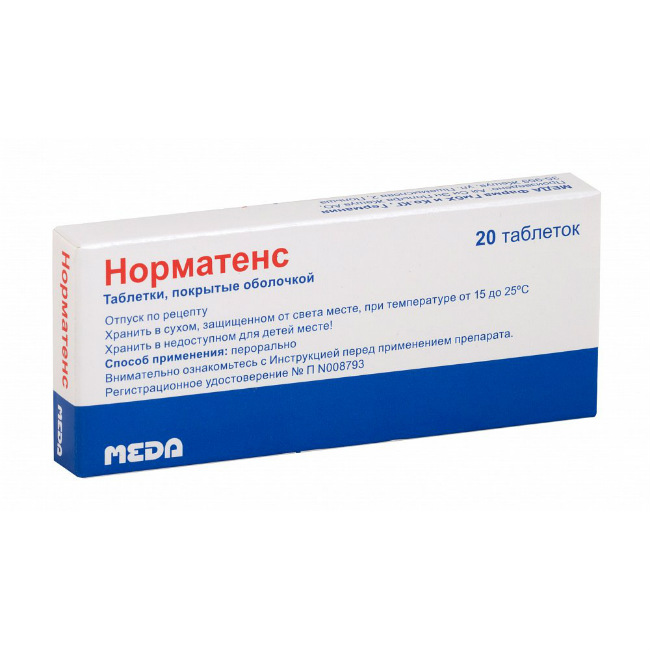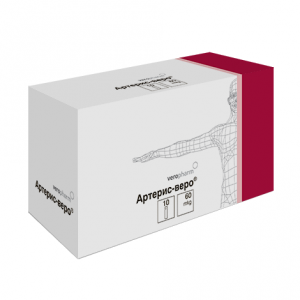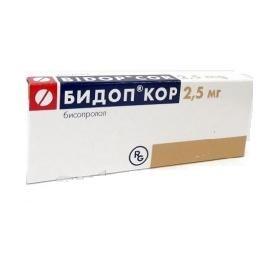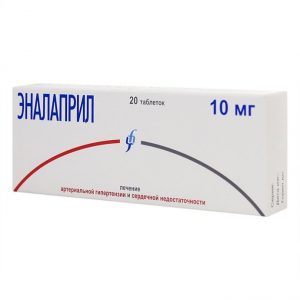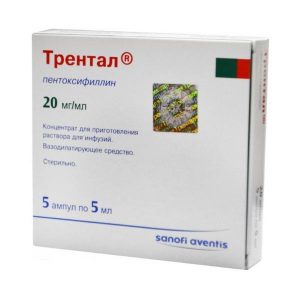Description
Release form
Tablets.
Packing
20 pcs.
Pharmacological action of
Clinical and pharmacological group: Antihypertensive drug
Pharmacotherapeutic group: Antihypertensive combined drug (sympatholytic + alpha-adrenergic blocking agent + diuretic)
Pharmacological action of
Anti-hypertensive drug contains a different combination.
Reserpine, a sympatholytic, penetrating the presynaptic ends of postganglionic sympathetic fibers, releases norepinephrine from the vesicles with a simultaneous violation of its reverse transport and intensification of the MAO inactivation process. It causes depletion of neurotransmitter reserves and a persistent decrease in blood pressure. Helps reduce the concentration of dopamine, serotonin and other neurotransmitters in neurons, providing an antipsychotic effect. It weakens the effect of sympathetic innervation on the cardiovascular system, reduces heart rate and OPSS, maintains the activity of the parasympathetic nervous system, deepens and enhances physiological sleep, inhibits interoreceptive reflexes. It increases the motility of the gastrointestinal tract, increases the production of hydrochloric acid in the stomach, slows down the metabolic processes in the body, reduces and deepens the respiratory movements, causes myosis, hypothermia reduces the metabolic rate. It has a positive effect on lipid and protein metabolism in patients with arterial hypertension and coronary atherosclerosis, increases renal blood flow, enhances glomerular filtration.
Clopamide is a medium-strength loop sulfanilamide diuretic that blocks the reabsorption of sodium ions at the level of the cortical segment of the Henle loop, and removes sodium, potassium, chlorine and water ions.
Dihydroergocristine is a dihydrogenated ergot alkaloid that blocks alpha-adrenergic receptors, causes vasodilation, reduces the overall peripheral vascular resistance. The hypotensive effect of the drug exceeds the hypotensive effect of each component separately and the effect of any combination of the two components onset is 4-7 days, lasting hypotensive effect is achieved after 1-4 weeks.
Pharmacokinetics
Absorption
The individual components of Normatens are absorbed after oral administration as follows: reserpine by about 30-40%, clopamide about 90% and dihydroergocristine less than 25%. Cmax in blood plasma is achieved accordingly: for reserpine – 1-3 hours, for clopamide – about 2 hours, for dihydroergocristine – about 1 hour.
Distribution of
Individual components of Normatens are easily distributed in the body (for example, for dihydroergocristine Vd is 52 l / kg ) Communication with blood plasma proteins: for reserpine, it does not bind, clopamide – about 46%, dihydroergocristine – about 68%. Reserpine and dihydroergocristine cross the BBB and through the placental barrier.
Metabolism
Reserpine and dihydroergocristine are extensively metabolized in the liver to inactive metabolites. Clopamide does not undergo significant metabolism in the liver.
The elimination of
T1 / 2 Normatens is long due to the presence of reserpine, for which T1 / 2 is in the first phase – 4.5 hours, and in the second – about 271 hours. The excretion route is different for the individual components: reserpine and dihydroergocristine – inactive metabolites are excreted in urine and feces, clopamide, mainly by the kidneys.
Contraindications
Hypersensitivity to any component of the drug.
Depression
Epilepsy.
Parkinson’s disease
Concomitant electroconvulsive therapy.
Pheochromocytoma.
Concomitant treatment with monoamine oxidase inhibitors (MAOs).
Peptic ulcer of the stomach and duodenum in the acute phase.
Erosive gastritis.
Nonspecific ulcerative colitis.
Angina pectoris.
Recently suffered myocardial infarction.
Chronic heart failure.
Severe bradycardia.
Atrioventricular block.
Intraventricular block.
Severe renal failure (CC below 30 ml / min).
Jade.
Uremia.
Nephrosclerosis.
Arterial hypotension.
Severe cerebral atherosclerosis.
Severe impairment of liver function.
Addison’s disease.
Hypokalemia.
Hyponatremia.
Hypochloremia.
Hyperuricemia with clinical manifestations.
Angle-closure glaucoma.
Violation of blood formation.
Pregnancy.
Lactation.
Bronchial asthma.
Age up to 18 years (efficacy and safety of use not established).
Precautions:
Diabetes.
Gout.
Old age.
Use during pregnancy and lactation
Since reserpine has a teratogenic effect, it is not recommended to use the Normatens drug during pregnancy.
In addition, reserpine may cause fetal arterial hypotension, bradycardia. In newborns, reserpine can contribute to rhinorrhea and swelling of the nasal mucosa, which leads to difficulty breathing and cyanosis.
Clopamide may cause thrombocytopenia in the fetus.
The drug should not be used during lactation. This is mainly due to the penetration of reserpine and dihydroergocristine into milk.
Dihydroergocristine can cause symptoms in newborns that are reminiscent of ergot poisoning, and in the mother, inhibit / weaken lactation.
Special instructions
Since the Normatens effect develops relatively slowly, the dosage should not be increased more than 1 time per week, due to the possibility of a pronounced decrease in blood pressure, special care must be taken if it is used with other antihypertensive drugs during treatment to periodically monitor the level Blood pressure to determine the optimal dosage regimen.
During treatment, serum glucose and uric acid levels may increase, periodic monitoring of these parameters is recommended, especially in patients with impaired glucose tolerance and hyperuricemia.
Renal function monitoring is necessary, especially in patients with chronic renal failure.
In case of bradycardia during the treatment period, the dose of the drug must be reduced or discontinued.
Serum potassium control is required during treatment. In most patients, additional prescription of potassium preparations is not required, provided that the diet contains a sufficient amount of foods rich in potassium (fruits, vegetables, fish, low-fat cheese, etc.).
Caution should be exercised in patients with bronchial asthma and bronchospasm, in case of exacerbation, it is necessary to stop taking Normatens.
At least 2 weeks before the planned surgical procedure, you should stop taking the drug and replace it with another antihypertensive drug.
Do not drink alcohol during treatment.
The dose of Normatens should be accordingly modified in case of simultaneous use of other drugs interacting with it.
7 days before the start of electroconvulsive therapy, Normatens should be canceled.
Influence on the ability to drive vehicles and work with mechanisms
Normatens may impair the patient’s ability to react quickly, especially at the beginning of treatment. During the treatment period, you should not drive vehicles and engage in any activities that require an increased concentration of attention and speed of psychomotor reactions.
Composition
1 tab.
reserpine 100 mcg
clopamide 5 mg
dihydroergocristine mesylate 580 mcg,
which corresponds to the content of dihydroergocristine 500 mcg
Excipients: lactose monohydrate – 44.9 mg, starch 2.5 mg, potassium starch – 25 mg, potassium hydroxide, 2.5 mg, 24 mg 0.875 mg.
Shell composition: crystalline sucrose – 44.80625 mg, acacia gum – 2.1375 mg, talc – 22.8875 mg, macrogol 6000 – 0. 16875 mg.
Dosage and administration
Inside, during or immediately after a meal, without chewing, with a small amount of liquid.
Dose sets individually. It is recommended to start treatment with 1 tab. 1 time / day, if necessary (lack of a satisfactory therapeutic effect), you can increase the dose of the drug to 2 times / day (every 12 hours) for 1 tab., And only in exceptional cases – up to 3 times / day (every 8 hours) for 1 tab ..
The maximum daily dose is 3 tablets.
Due to the mechanism of action of the drug, the possible lack of efficacy of the drug can be discussed no earlier than 2 weeks after the start of administration, therefore, during this period, the initial dose should not be increased unnecessarily.
With prolonged treatment, in case of a satisfactory therapeutic effect, it is recommended to take 1 tab. 1 time / day, and in some patients the dose of the drug can be reduced to 1 tab. 1 time in a day. With each dose reduction, blood pressure control is necessary.
When carrying out maintenance therapy should not exceed the dose – 2 tablets / day.
Side effects of the digestive system: diarrhea, dry mouth, abdominal pain, nausea, vomiting, exacerbation of peptic ulcer disease, decreased appetite. Rarely – ulceration of the mucous membrane of the stomach and duodenum, gastrointestinal bleeding when using reserpine in a dose above 1 mg / day (the amount contained in 10 tab. Normatens).
From the cardiovascular system: bradycardia, decreased blood pressure, cerebrovascular disorders, orthostatic hypotension.
From the side of the central nervous system: headache, dizziness, drowsiness, weakness, anxiety, impaired attention, insomnia, extrapyramidal disorders (tremor, stupor, Parkinson’s syndrome)
Since reserpine is part of the drug, it should be borne in mind that depressive reactions (including suicidal tendencies) and depressive syndrome can occur and such symptoms rarely occur and only when large doses of reserpine are used (more than 1 mg / day, which corresponds to a reserpine content of more than 10 tab. Normatens).
From the respiratory system: hyperemia and swelling of the mucous membrane of the nasal cavity. Reserpine can cause symptoms of bronchospasm, however, this effect is rare, and, as a rule, in patients with bronchial asthma or bronchial obstructive syndrome.
Allergic reactions: skin rash, itching.
Hematopoietic organs: thrombocytopenia with symptoms of hemorrhagic diathesis.
Laboratory parameters: hypokalemia, hypomagnesemia, hypocalcemia, metabolic alkalosis, hyperuricemia, hyperglycemia, a slight increase in the content of triglycerides, cholesterol.
Other: galactorrhea.
With prolonged use in high doses – paresthesia, decreased libido, decreased potency, gynecomastia, impaired urination, accommodation spasm, conjunctival hyperemia, hypothermia.
Drug Interactions
Reduces the effectiveness of oral hypoglycemic drugs, tricyclic antidepressants, anticoagulants.
Increases the concentration of lithium in blood plasma (slowing down its excretion).
Reduces the effect of antiepileptic drugs and levodopa, anticholinergics, reduces the analgesic effect of morphine.
Enhances the action of barbiturates, ethanol, drugs for inhalation anesthesia, antihistamines.
Enhances the action of adrenergic agonists.
Barbiturates, ethanol, beta-blockers, peripheral vasodilators enhance the hypotensive effect.
Glucocorticosteroids, non-steroidal anti-inflammatory drugs, laxative drugs reduce diuretic, hypotensive effects, increase the risk of hypokalemia.
On the background of treatment with MAO inhibitors, an increase in the inhibitory effect on the central nervous system.
During treatment with the drug, MAO inhibitors cause moderate or severe arterial hypertension, hyperreflexia.
Antiarrhythmic drugs – in case of hypokalemia, which may accompany treatment, the risk of toxic effects of amiodarone increases, disopyramide, quinidine hypokalemia weakens the effect of lidocaine, mexiletine.
Not recommended combination with dopamine (increased vasoconstrictor reaction).
When used together with digoxin, the risk of bradycardia in case of hypokalemia, which may accompany treatment, is increased, and the risk of increased adverse reactions of digoxin is increased.
Overdose
Symptoms: nausea, vomiting, diarrhea, muscle weakness, dizziness, headache, severe BP, bradycardia, arrhythmias, depression, hyporeflexia, confusion and coma.
Treatment: As a first aid, if the patient is conscious, it should cause vomiting, gastric lavage or activated charcoal. Conducting symptomatic therapy aimed at maintaining cardiovascular function, correcting electrolyte balance.
Reserpine, a part of Normatens, is not excreted by dialysis.
Storage conditions
Store in a dry, dark place at 15 ° C to 25 ° C. Keep out of reach of children.
Shelf life
5 years.
dosage form
tablets
Possible product names
NORMATENSION N20 TABLE S / L
NORMATENS DRAGE N20
NORMATENS tab s / s x 20
NORMAL TAB. P.O. 20
NORMATENS TAB. P / O No. 20
